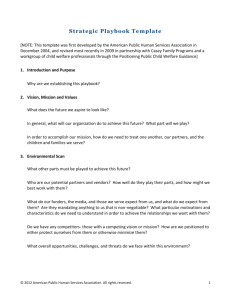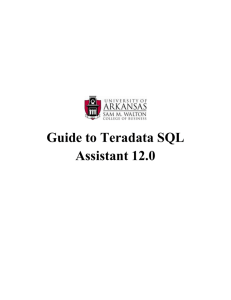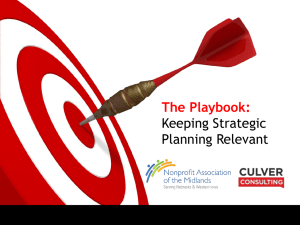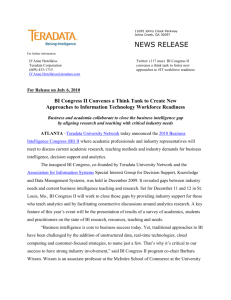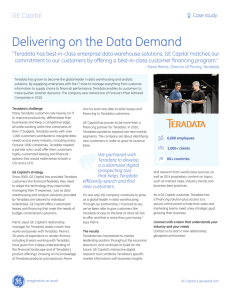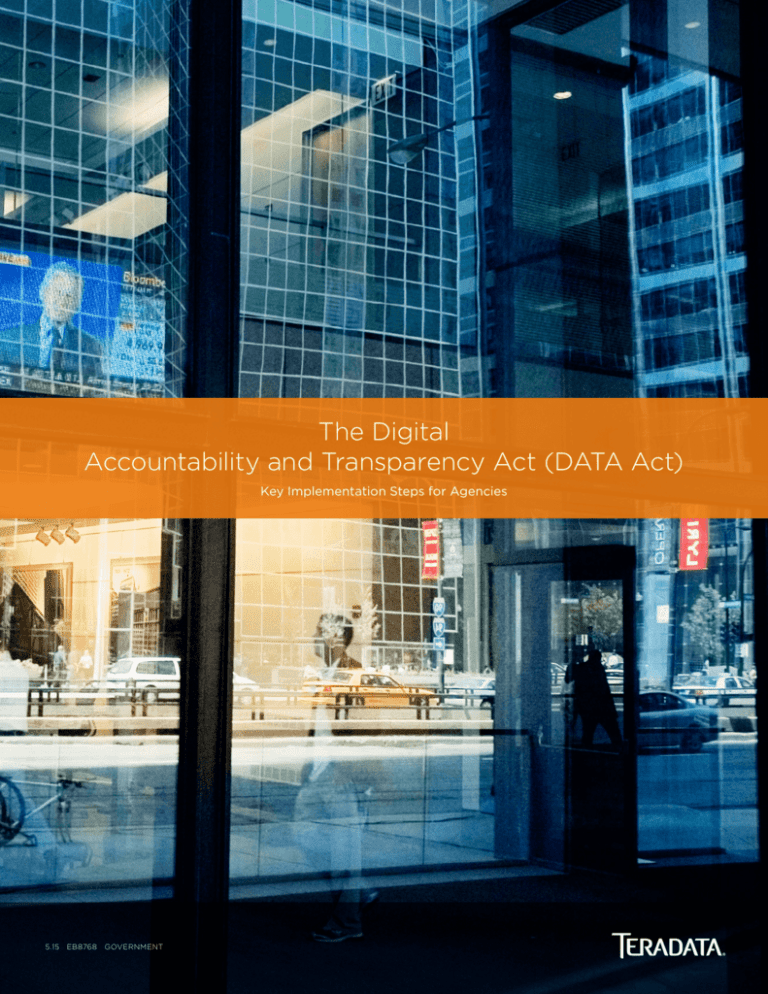
The Digital
Accountability and Transparency Act (DATA Act)
Key Implementation Steps for Agencies
5.15 EB8768 GOVERNMENT
Introduction
On May 9, 2014, President Obama signed the Digital Accountability and Transparency Act (the DATA Act)
into law. Unprecedented in its focus, the DATA Act requires Federal agencies to report all expenditures—
grants, loans, and contracts—in order to provide American citizens and policy makers better visibility into
federal spending.
The law seeks to improve the quality of federal spending
data through the establishment of government-wide data
standards, and provides that the data be published on
an updated version of USAspending.gov. As eloquently
stated by the Data Transparency Coalition, the law
ultimately “requires the government to transform its
spending from disconnected documents into open data.” 1
As unanimously-passed legislation, nearly everyone agrees
that the goals of the DATA Act are essential. However,
many of the federal government’s historical challenges that
necessitated the new mandate—challenges concerning
data quality and other data management practices—
are precisely why some agencies have anxiety about
implementing requirements under the new law.
These recommendations should be
evaluated carefully as agencies design their
own implementation plans, from a staffing
and process perspective.
•• Each agency may have different
approaches to implementation, which is to
be expected
•• Not every step is required for all agencies
•• The sequence and number of individual
milestones may differ, and not all roles
apply to every agency
Compliance Milestones
To assist agencies in their effort to meet the new DATA
Act compliance requirements, this document provides an
overview of high-level target milestones and strategies to
help ensure successful implementation. Agencies should
note the agile nature of the program, and the importance
of following the most important authoritative sources for
2
THE DIGITAL ACCOUNTABILITY AND TRANSPARENCY ACT (DATA ACT)
guidance on the DATA Act, which are the U.S. Treasury
and Office of Management and Budget (OMB). These
DATA Act implementation lead agencies have created
the DATA Act Playbook to help agencies meet DATA
Act requirements in a transformative way that provides
greater benefit, beyond compliance. The approaches
outlined in this document align to the principles and
steps in the playbook. (Since the originial publication
of this document, OMB and Treasury released the DATA
Act Playbook. Where appropriate, we have crossreferenced the recommendations in this document with
those of the playbook.)
While many agencies have already taken steps
toward implementation, everyone affected is
encouraged to regularly monitor released information
via the DATA Act federal spending transparency
collaboration space managed by the U.S. Treasury at
fedspendingtransparency.github.io/. It is also important
to collaborate with the decision-making teams at the
lead implementation agencies—not only often, but early.
Early agency adopters can benefit from their proactive
measures. By being ahead of the curve, they can better
understand direction provided by the U.S. Treasury and
OMB, and possibly help shape its direction in some way,
as noted in Step 2 of the playbook.
Time Is On Your Side
The good news for federal agencies is that the law
doesn’t require extensive new reporting requirements;
rather, simply “some kind of electronic structure for
the reporting requirements that already exist,” 2 as
addressed, in part, by the broker referenced in steps
5 and 6 of the playbook. Further, the implementation
timeline provides agencies sufficient lead time to
prepare for more transparent reporting as outlined by
the DATA Act, which is currently scheduled to go into
effect May 2017.
The recommended actions outlined herein take into consideration several assumptions and constraints, such as:
•• No funding accompanied DATA Act legislation, so
agencies will need to fund their overall DATA Act
efforts with program dollars or cost savings leveraged
elsewhere.
Officer; Project Management Office; and the financial
management user community. This will put you well on
your way to completing Step 1 in the playbook.
•• The DATA Act standards, implementation approach
and Treasury guidance are iterative in nature, and will
evolve over time, so agencies are expected to respond
and adjust accordingly.
3. Coordinate internal agency communities (e.g.,
procurement, budget, CFO, CIO) to provide feedback
implementation to the U.S. Treasury and OMB on the
DATA Act implementation and data standards. 3 (see
playbook Step 2)
•• Treasury expects and encourages agencies to be
involved in the development of DATA Act standards
and processes.
Leverage previous work applicable to the DATA Act.
What Agencies Can Do To Prepare
Right Now
Get educated, get involved.
1. Become familiar with DATA Act requirements, standards
and resources , and participate in shaping the standards
as directed in Step 2 of the playbook. Information on the
DATA Act can be found on the following sites:
– DATA Act Playbook Summary: https://www.usaspending.gov/Documents/Summary%20of%20
DATA%20Act%20Playbook.pdf
•• Revisit existing reporting processes for USAspending.
gov; repurpose best practices and make improvements
where necessary (see playbook Steps 3 and 4)
•• Assess ability to meet DATA Act requirements
•• Identify funding sources for DATA Act (i.e., cost savings
or other monetization of DATA Act information)
•• Inventory current data-related IT assets and capabilities
(see playbook Step 3)
•• Focus staff on becoming more data-driven
– Better data, Better decisions, Better government, OMB and Treasury Blog: https://
www.whitehouse.gov/blog/2015/05/08/
better-data-better-decisions-better-government
Leverage U.S. Treasury and OMB efforts.
– DATA Act Legislation: www.congress.gov/
bill/113th-congress/senate-bill/994
•• Follow progress and outcomes of DATA Act pilots (i.e.
grants pilot at HHS)
– ACT-IAC Big Data Shared Interest Group: actiac.org/
tags/big-data
•• Contact the Data Transparency team
directly for specific advice and guidance at
fedspendingtransparency.github.io/
– Data Transparency Coalition: www.datacoalition.org
– USAspending.gov: www.usaspending.gov
– Financial Spending Transparency Collaboration
Space – Data Element Feedback Forum: fedspendingtransparency.github.io/dataelements/ List of
draft data elements published by Treasury
– Data.gov: www.data.gov
– ACT-IAC’s project page for the DATA
Act - Transparency in Federal Financials
Project: https://actiac.org/project/
data-act-transparency-federal-financials-project
2. Engage other key stakeholders within your agency
who can assist with implementation, such as data
governance teams; IT resources; the Chief Data
3
•• Identify existing standards and processes around data
governance (see playbook Step 3)
TERADATA.COM
•• Use resources on the U.S. Treasury collaboration site and
voice your input on DATA Act elements and standards
(see playbook Step 2)
•• Coordinate agency data-related IT investments with
Treasury architecture as a basis for system compatibility
(see playbook Step 5)
Establish a vision for leveraging your financial
data—beyond basic compliance with the DATA
Act—for becoming a data-driven financial
organization.
•• What inquiries does your Agency commonly get—by
way of “data calls” or otherwise—that you scramble
every time to answer? Find ways to improve existing
processes through DATA Act compliance (see playbook
Steps 4 and 7)
•• Using this vision will help build a business case for
potential required investments; in people and technology
•• Determine focus areas where data can be used to
improve financial management. These focus areas
could include:
– Stewardship
– Controllership
– Data governance
– Performance management
– Transparency and reporting
•• Communicate the vision and solicit feedback from
all stakeholders, i.e. user community, management,
external parties and other governmental entities
•• Look beyond DATA Act compliance with an aim toward
building an open and extensible data ecosystem
•• Identify resources that may be required for DATA Act
implementation: people, tools, technology
Planning Outlook
Look for ongoing, informative updates from Teradata
on DATA Act implementation for government agencies
between now and May 2017, the scheduled effective
compliance date. We’ll be sure to cover important key
strategies for proper preparation, including:
law. Agencies that prepare early on will find opportunities
to turn their compliance efforts into a greater benefit
for their organization as a whole, resulting in increased
operational efficiencies and well-founded confidence in
their data. A broader, more complete understanding of an
agency’s financial data will better enable program leaders
to defend the criticality of their budgets and manage
program dollars more effectively, long into the future.
Teradata and the Data Transparency Coalition
Teradata, a global leader in analytic data platforms, has
analyzed DATA Act requirements and identified an array of
services such as data visualization, analytics, warehousing,
integration and others that agencies can consider for more
seamless adoption of the data standards and reporting.
Teradata is a founding member of the Data Transparency
Coalition (DTC), and helped lead the charge in getting
the legislation passed. Through the DATA Act, the DTC
is transforming federal spending, thanks to Teradata’s
support and the growth we have championed.
About Teradata
•• Mapping existing agency data to new standards
Teradata helps government agencies get more value
from data than any other company. Our big data analytic
solutions, integrated marketing applications, and team
of experts can help your organization achieve actionable
insights with data. Teradata helps organizations leverage
all their data so they can know more about their citizens
and agency outcomes and do more of what’s really
important. Visit teradata.com/government.
•• Preparing for DATA Act audits
References
•• Getting familiar with financial data standards published
by the U.S. Treasury and OMB
•• Establishing a strong DATA Act team
•• And more
While the time and effort required by the DATA Act
may seem daunting, agencies that properly prepare
for implementation will see their work result in tangible
benefits—above and beyond simple compliance with the
Source: “Data Transparency: Oversight Needed to Address Underreporting
and Inconsistencies on Federal Award Website,” United States Government
Accountability Office, June 2014 (www.gao.gov/assets/670/664536.pdf).
1
2
Source: “The DATA Act Passes: 3 Takeaways and Interactive Timeline,” Government
Technology May 12, 2014
3
ource: Implementing the DATA Act: Treasury Roadmap Briefing to the CFO
S
Council, June 4, 2014
4
ource: Data Transparency Coalition (www.datacoalition.org/what-is-dataS
transparency/data-act/).
10000 Innovation Drive, Dayton, OH 45342 Teradata.com
Teradata and the Teradata logo are registered trademarks of Teradata Corporation and/or its affiliates in the U.S. and worldwide. Teradata continually improves products as
new technologies and components become available. Teradata, therefore, reserves the right to change specifications without prior notice. All features, functions and operations
described herein may not be marketed in all parts of the world. Consult your Teradata representative or Teradata.com for more information.
Copyright © 2015 by Teradata Corporation All Rights Reserved. Produced in U.S.A.
5.15 EB8768


